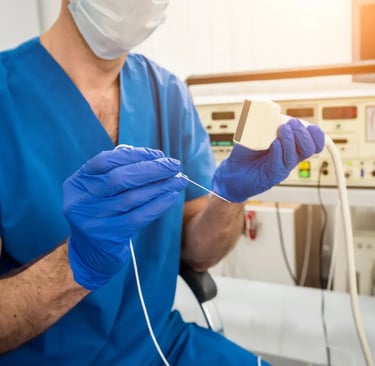Top Safety Protocols for Managing High-Risk Medical Devices
11/17/20252 min read


High-risk medical devices play a crucial role in patient care, supporting life, monitoring vital functions, and facilitating accurate diagnosis. Because these devices directly impact patient safety, healthcare facilities must implement strict protocols to ensure proper handling, maintenance, and risk control. Effective management not only prevents equipment failure but also safeguards both clinicians and patients from avoidable harm.
Below are the top safety protocols every healthcare organization should follow when managing high-risk medical devices.
1. Conduct Comprehensive Risk Assessments
Before a medical device is deployed in clinical settings, it must undergo a detailed risk assessment. This includes:
Identifying potential failure modes
Evaluating patient safety risks
Reviewing manufacturer safety guidelines
Assessing compatibility with existing systems
Regular risk assessments help facilities proactively address hazards and update procedures as equipment evolves.
2. Ensure Proper Staff Training & Certification
High-risk devices should only be handled by trained and authorized personnel. Effective training programs must include:
Correct device operation and troubleshooting
Emergency protocols
Regular competency evaluations
Updates on new features or manufacturer advisories
Continuous education ensures staff can respond quickly and safely to any device-related issue.
3. Implement Preventive Maintenance Schedules
Preventive maintenance (PM) is one of the strongest safeguards against device failure. A structured PM program should involve:
Routine inspections
Functional testing
Calibration
Performance verification
Replacement of worn components
Following manufacturer-recommended maintenance intervals significantly reduces unexpected downtime and safety risks.
4. Maintain Accurate Documentation & Asset Tracking
Proper documentation is crucial to maintaining transparency and ensuring compliance. Healthcare facilities should maintain:
Device history records (DHR)
Maintenance logs
Calibration certificates
Incident and corrective action reports
Warranty and service contracts
Using a digital asset tracking system enhances traceability, minimizes errors, and enables facilities to ensure that devices remain compliant with regulatory standards.
5. Implement Strict Infection Control Measures
High-risk medical devices often come into direct contact with patients, making infection control essential. Protocols should include:
Proper cleaning and disinfection between uses
Sterilization procedures for invasive devices
Use of approved disinfectants
Adherence to CDC and facility-specific guidelines
Following these measures minimizes the risk of cross-contamination and keeps both patients and clinicians safe.
6. Conduct Regular Safety Audits
Periodic safety audits allow facilities to evaluate compliance and identify gaps in device management practices. Audits should assess:
Proper device storage
Training adherence
Maintenance compliance
Incident reports and trend analysis
Audit findings should be used to strengthen safety protocols and improve overall device reliability.
7. Establish a Clear Incident Reporting System
When device malfunctions occur, quick reporting helps prevent repeated issues. A successful incident reporting system should enable:
Easy reporting for staff
Immediate escalation for critical failures
Root cause analysis
Implementation of corrective and preventive actions (CAPA)
Early detection and reporting protect patients and reduce operational risks.
8. Monitor Manufacturer Updates & Regulatory Changes
High-risk medical devices are subject to frequent updates, recalls, and safety notices. Healthcare facilities must actively monitor:
Manufacturer advisories
FDA updates and recall notices
New regulatory requirements
Emerging industry best practices
Staying informed ensures devices remain safe, compliant, and up-to-date.
Conclusion
Managing high-risk medical devices requires a structured, disciplined approach rooted in training, maintenance, documentation, and compliance. By implementing these safety protocols, healthcare facilities not only protect their patients but also ensure efficient operations and long-term device performance.
Services
Expert repair and inspection for medical equipment. Follow us on socials
Ready to streamline your medical equipment services? Call us today! 732 928 4212
© 2024. All rights reserved.


